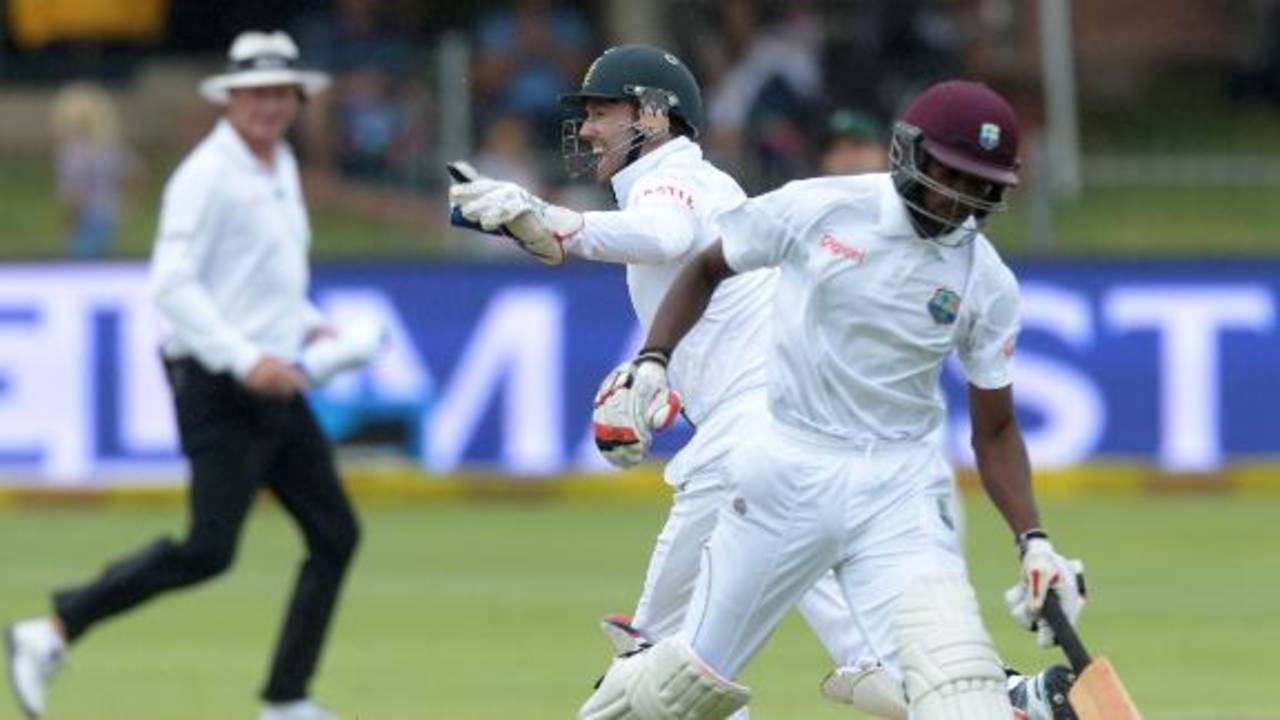Even when less than half a match has been played, when spoils have been shared and when the greatest commitment was shown by the groundstaff who tirelessly carried covers, mopped, swept and even tried a leaf blower as a makeshift dryer, there is a search for a winner and a loser. Such is the nature of a competitive sport. It is only satisfied when that division is clear.
In the 201 overs bowled at St George's Park, there were 692 runs scored and 17 wickets taken. South Africa came out with the points advantage, but still West Indies were spoken about more and made to feel as though they were the ones who had greater gains to celebrate.
"We were disappointed in the first game and we definitely wanted to improve. We had two centurions against the No.1 bowling attack in the world after we didn't even manage a fifty in Centurion," Stuart Williams, West Indies coach, said. "We were more consistent with the ball - Shannon Gabriel with his pace and Kenroy Peters, the debutant, although he is in the latter stage of his career, showed he could put his hand up."
Progress, in other words, is what West Indies are being praised for. After being blown away in Centurion, they could have arrived in Port Elizabeth in pieces but pulled themselves together. Jerome Taylor tightened his lines, the batting line-up - or at least two players - tightened their approach and the result was a more competitive performance on a surface which favoured a different style of play.
Instead of the fierce cricket Centurion's SuperSport Park demands - pace and bounce results in higher scoring run-rates and a greater frequency of wickets - St George's Park calls for more industrious play. Run-scoring is laboured because the ball does not come as much as it does up country, wicket-taking is hard work because breaking through requires innovation rather than aggression.
That much was evident when South Africa were batting.
Dean Elgar and
Faf du Plessis operated within a bubble that barely extended beyond their off stump when it came to the type of deliveries they were willing to play at, never mind look to score from.
Kraigg Brathwaite and
Marlon Samuels copied that and defied the South African attack. Their approach was less conservative, if only because they were caught between the urgency of evasive action against the quicks, particularly Morne Morkel, and the invitations to attack they were given by Imran Tahir.
Their 176-run partnership was a record for West Indies - the largest for the third-wicket against South Africa - and they will regard it in the same way South Africa did the Hashim Amla-AB de Villiers stand in the first Test. Why not? It did not extend over 300 runs like the South African one but it still propped up the innings and will be used as a blueprint for future games. "What we've got to take from here is the way Marlon and Kraigg batted," Williams said.
South Africa, though, believe that is actually all West Indies can take out of their batting performance. "They had one good partnership and that partnership reflected the feeling they had a good game," Amla said. "To get seven wickets in 35 overs was a really good effort so we had a pretty good game as well. There was not a lot of pace in the pitch, it was keeping low and it was difficult to get the ball to swing. It became difficult for the seam bowlers. Skills were tested and our bowlers came out on top."
The collapse South Africa engineered, chiefly through Morkel's around-the-wicket angle and use of the short ball, gave them a chance to push for victory on the final day but they needed the weather to be on their side. "We were hoping to bowl them out early this morning, set a target and then win the game. With 55 or 60 overs, it would have been a pretty good game," Amla said.
On an outfield that had absorbed more rain than the drainage could handle there was not even a ball bowled. But it was not for lack of trying. Adrian Carter, the head groundsman, and his team did everything they could to soak up the sludge but one look at the container placed in the press box to collect water from a leaking ceiling put into perspective the magnitude of their task.
When the rain first came on the second day, the water barely rose a centimetre from the bottom. By 1pm on the final afternoon, when the match was called off, the level had risen to almost the top. The bucket was about 40cm deep.
"I think it just rained too much," Amla said. When that happens, there is only one real winner and we all know it's not one of the teams.
Firdose Moonda is ESPNcricinfo's South Africa correspondent
